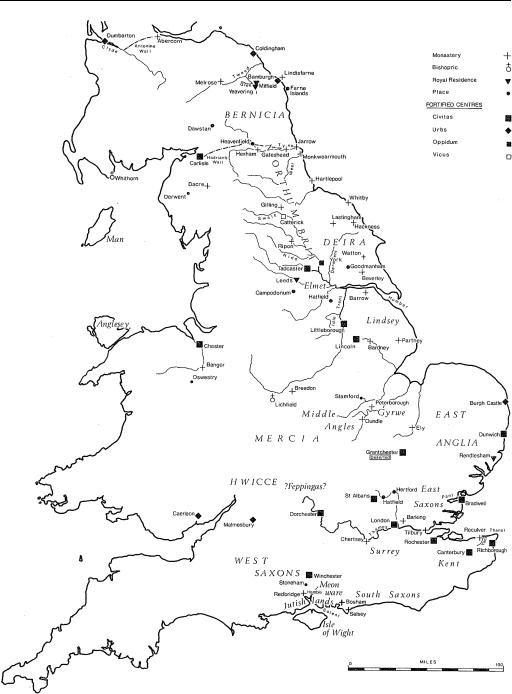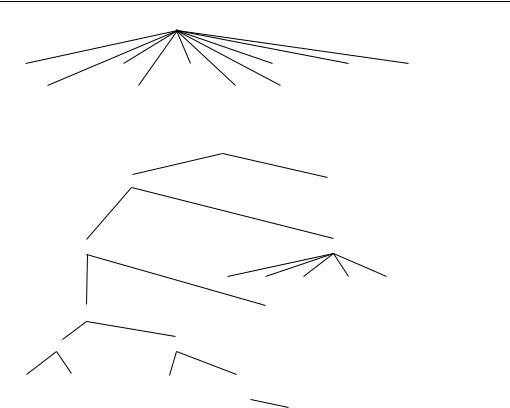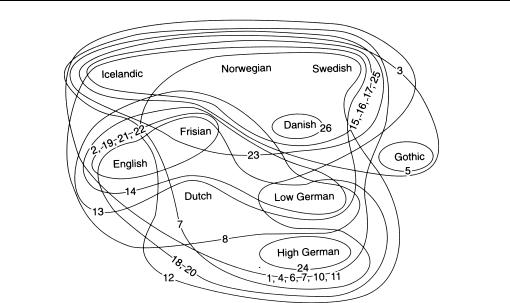
- •Contents
- •Figures
- •Tables
- •Contributors
- •Preface
- •Acknowledgements
- •1 Overview
- •1.1 Introduction
- •1.2 The roots of English
- •1.3 Early history: immigration and invasion
- •1.4 Later history: internal migration, emigration, immigration again
- •1.5 The form of historical evidence
- •1.6 The surviving historical texts
- •1.7 Indirect evidence
- •1.8 Why does language change?
- •1.9 Recent and current change
- •2 Phonology and morphology
- •2.1 History, change and variation
- •2.2 The extent of change: ‘vertical’ and ‘horizontal’ history
- •2.3 Tale’s end: a sketch of ModE phonology and morphology
- •2.3.1 Principles
- •2.3.2 ModE vowel inventories
- •2.3.3 ModE consonant inventories
- •2.3.4 Stress
- •2.3.5 Modern English morphology
- •2.4 Old English
- •2.4.1 Time, space and texts
- •2.4.2 The Old English vowels
- •2.4.3 The Old English consonants
- •2.4.4 Stress
- •2.4.5 Old English morphology
- •2.4.5.1 The noun phrase: noun, pronoun and adjective
- •2.4.5.2 The verb
- •2.4.6 Postlude as prelude
- •2.5 The ‘OE/ME transition’ to c.1150
- •2.5.1 The Great Hiatus
- •2.5.2 Phonology: major early changes
- •2.5.2.1 Early quantity adjustments
- •2.5.2.2 The old diphthongs, low vowels and /y( )/
- •2.5.2.3 The new ME diphthongs
- •2.5.2.4 Weak vowel mergers
- •2.5.2.5 The fricative voice contrast
- •2.6.1 The problem of ME spelling
- •2.6.2 Phonology
- •2.6.2.2 ‘Dropping aitches’ and postvocalic /x/
- •2.6.2.4 Stress
- •2.6.3 ME morphology
- •2.6.3.2 The morphology/phonology interaction
- •2.6.3.3 The noun phrase: gender, case and number
- •2.6.3.4 The personal pronoun
- •2.6.3.5 Verb morphology: introduction
- •2.6.3.6 The verb: tense marking
- •2.6.3.7 The verb: person and number
- •2.6.3.8 The verb ‘to be’
- •2.7.1 Introduction
- •2.7.2 Phonology: the Great Vowel Shift
- •2.7.4 English vowel phonology, c.1550–1800
- •2.7.5 English consonant phonology, c.1550–1800
- •2.7.5.1 Loss of postvocalic /r/
- •2.7.5.2 Palatals and palatalisation
- •2.7.5.3 The story of /x/
- •2.7.6 Stress
- •2.7.7 English morphology, c.1550–1800
- •2.7.7.1 Nouns and adjectives
- •2.7.7.2 The personal pronouns
- •2.7.7.3 Pruning luxuriance: ‘anomalous verbs’
- •2.8.1 Preliminary note
- •2.8.2 Progress, regress, stasis and undecidability
- •2.8.2.1 The evolution of Lengthening I
- •2.8.2.2 Lengthening II
- •3 Syntax
- •3.1 Introduction
- •3.2 Internal syntax of the noun phrase
- •3.2.1 The head of the noun phrase
- •3.2.2 Determiners
- •3.3 The verbal group
- •3.3.1 Tense
- •3.3.2 Aspect
- •3.3.3 Mood
- •3.3.4 The story of the modals
- •3.3.5 Voice
- •3.3.6 Rise of do
- •3.3.7 Internal structure of the Aux phrase
- •3.4 Clausal constituents
- •3.4.1 Subjects
- •3.4.2 Objects
- •3.4.3 Impersonal constructions
- •3.4.4 Passive
- •3.4.5 Subordinate clauses
- •3.5 Word order
- •3.5.1 Introduction
- •3.5.2 Developments in the order of subject and verb
- •3.5.3 Developments in the order of object and verb
- •3.5.5 Developments in the position of particles and adverbs
- •3.5.6 Consequences
- •4 Vocabulary
- •4.1 Introduction
- •4.1.1 The function of lexemes
- •4.1.3 Lexical change
- •4.1.4 Lexical structures
- •4.1.5 Principles of word formation
- •4.1.6 Change of meaning
- •4.2 Old English
- •4.2.1 Introduction
- •4.2.4 Word formation
- •4.2.4.1 Noun compounds
- •4.2.4.2 Compound adjectives
- •4.2.4.3 Compound verbs
- •4.2.4.7 Zero derivation
- •4.2.4.8 Nominal derivatives
- •4.2.4.9 Adjectival derivatives
- •4.2.4.10 Verbal derivation
- •4.2.4.11 Adverbs
- •4.2.4.12 The typological status of Old English word formation
- •4.3 Middle English
- •4.3.1 Introduction
- •4.3.2 Borrowing
- •4.3.2.1 Scandinavian
- •4.3.2.2 French
- •4.3.2.3 Latin
- •4.3.3 Word formation
- •4.3.3.1 Compounding
- •4.3.3.4 Zero derivation
- •4.4 Early Modern English
- •4.4.1 Introduction
- •4.4.2 Borrowing
- •4.4.2.1 Latin
- •4.4.2.2 French
- •4.4.2.3 Greek
- •4.4.2.4 Italian
- •4.4.2.5 Spanish
- •4.4.2.6 Other languages
- •4.4.3 Word formation
- •4.4.3.1 Compounding
- •4.5 Modern English
- •4.5.1 Introduction
- •4.5.2 Borrowing
- •4.5.3 Word formation
- •4.6 Conclusion
- •5 Standardisation
- •5.1 Introduction
- •5.2 The rise and development of standard English
- •5.2.1 Selection
- •5.2.2 Acceptance
- •5.2.3 Diffusion
- •5.2.5 Elaboration of function
- •5.2.7 Prescription
- •5.2.8 Conclusion
- •5.3 A general and focussed language?
- •5.3.1 Introduction
- •5.3.2 Spelling
- •5.3.3 Grammar
- •5.3.4 Vocabulary
- •5.3.5 Registers
- •Electric phenomena of Tourmaline
- •5.3.6 Pronunciation
- •5.3.7 Conclusion
- •6 Names
- •6.1 Theoretical preliminaries
- •6.1.1 The status of proper names
- •6.1.2 Namables
- •6.1.3 Properhood and tropes
- •6.2 English onomastics
- •6.2.1 The discipline of English onomastics
- •6.2.2 Source materials for English onomastics
- •6.3 Personal names
- •6.3.1 Preliminaries
- •6.3.2 The earliest English personal names
- •6.3.3 The impact of the Norman Conquest
- •6.3.4 New names of the Renaissance and Reformation
- •6.3.5 The modern period
- •6.3.6 The most recent trends
- •6.3.7 Modern English-language personal names
- •6.4 Surnames
- •6.4.1 The origin of surnames
- •6.4.2 Some problems with surname interpretation
- •6.4.3 Types of surname
- •6.4.4 The linguistic structure of surnames
- •6.4.5 Other languages of English surnames
- •6.4.6 Surnaming since about 1500
- •6.5 Place-names
- •6.5.1 Preliminaries
- •6.5.2 The ethnic and linguistic context of English names
- •6.5.3 The explanation of place-names
- •6.5.4 English-language place-names
- •6.5.5 Place-names and urban history
- •6.5.6 Place-names in languages arriving after English
- •6.6 Conclusion
- •Appendix: abbreviations of English county-names
- •7 English in Britain
- •7.1 Introduction
- •7.2 Old English
- •7.3 Middle English
- •7.4 A Scottish interlude
- •7.5 Early Modern English
- •7.6 Modern English
- •7.7 Other dialects
- •8 English in North America
- •8.1.1 Explorers and settlers meet Native Americans
- •8.1.2 Maintenance and change
- •8.1.3 Waves of immigrant colonists
- •8.1.4 Character of colonial English
- •8.1.5 Regional origins of colonial English
- •8.1.6 Tracing linguistic features to Britain
- •8.2.2 Prescriptivism
- •8.2.3 Lexical borrowings
- •8.3.1 Syntactic patterns in American English and British English
- •8.3.2 Regional patterns in American English
- •8.3.3 Dictionary of American Regional English (DARE)
- •8.3.4 Atlas of North American English (ANAE)
- •8.3.5 Social dialects
- •8.3.5.1 Socioeconomic status
- •8.3.6 Ethnic dialects
- •8.3.6.1 African American English (AAE)
- •8.3.6.2 Latino English
- •8.3.7 English in Canada
- •8.3.8 Social meaning and attitudes
- •8.3.10 The future of North American dialects
- •Appendix: abbreviations of US state-names
- •9 English worldwide
- •9.1 Introduction
- •9.2 The recency of world English
- •9.3 The reasons for the emergence of world English
- •9.3.1 Politics
- •9.3.2 Economics
- •9.3.3 The press
- •9.3.4 Advertising
- •9.3.5 Broadcasting
- •9.3.6 Motion pictures
- •9.3.7 Popular music
- •9.3.8 International travel and safety
- •9.3.9 Education
- •9.3.10 Communications
- •9.4 The future of English as a world language
- •9.5 An English family of languages?
- •Further reading
- •1 Overview
- •2 Phonology and morphology
- •3 Syntax
- •4 Vocabulary
- •5 Standardisation
- •6 Names
- •7 English in Britain
- •8 English in North America
- •9 English worldwide
- •References
- •Index

1 Overview
David Denison and Richard Hogg
1.1Introduction
David Crystal estimates that about 400 million people have English as their first language, and that in total as many as 1500 million may be to a greater or lesser extent fluent speakers of English (see Chapter 9, Table 9.1). The two largest countries (in terms of population) where English is the inherited national language are Britain and the USA. But it is also the majority language of Australia and New Zealand, and a national language in both Canada and South Africa. Furthermore, in other countries it is a second language, in others an official language or the language of business.
If, more parochially, we restrict ourselves to Britain and the USA, the fact that it is the inherited national language of both does not allow us to conclude that English shows a straightforward evolution from its ultimate origins. Yet originally English was imported into Britain, as also happened later in North America. And in both cases the existing languages, whether Celtic, as in Britain, or Amerindian languages, as in North America, were quickly swamped by English. But in both Britain and the USA, English was much altered by waves of immigration. Chapter 8 will demonstrate how that occurred in the USA.
In Britain, of course, the Germanic-speaking Anglo-Saxons brought their language with them as immigrants. The eighth and ninth centuries saw Scandinavian settlements and then the Norman Conquest saw significant numbers of Frenchspeaking settlers. Both these invasions had a major impact on the language, which we shall discuss later in this chapter. However, they should not obscure the constant influence of other languages on English, whether through colonisation or through later immigration. Some idea of the polyglot nature of the language (as opposed to its speakers) can be gleaned from the figures presented in Table 1.1, based upon etymologies in the Oxford English Dictionary. (Note that the alreadyexisting language English did not get its basic vocabulary and structure from any of the languages in Table 1.1; the origins of English will be introduced shortly.)
The OED is probably the most complete historical dictionary of any language. The languages in Table 1.1 have been chosen (from over 350 in OED!) only in order to demonstrate the variety of linguistic sources for English. The figures in Table 1.1 remain imprecise, despite elaborate electronic searches of the entire OED (with its 20+ ways of marking a French loan and 50+ for Scandinavian): exact figures are beside the point and in fact unattainable.
1

2 D AV I D D E N I S O N A N D R I C H A R D H O G G
Table 1.1 Some sources of English words (OED2)
Latin |
24,940 |
French |
9,470 |
Scandinavian |
1,530 |
Spanish |
1,280 |
Dutch, including Afrikaans |
860 |
Arabic |
615 |
Turkish |
125 |
Hindi |
120 |
Hungarian |
26 |
Cherokee |
1–3 |
|
|
|
|
Even when we are dealing with only one country, say Britain or the USA, there are a wide range of varieties of English available. These varieties are dependent on various factors. Each speaker is different from every other speaker, and often in non-trivial ways. Thus speaker A may vary from speaker B in geographical dialect. And the context of speech varies according to register, or the social context in which the speaker is operating at the time. Register includes, for example, occupational varieties, and it interacts with such features as the contrast between written and spoken language (medium) or that between formal and colloquial language.
It will be clear that the above points raise the question of what this volume purports to be a history of. There are, we can now see, many different Englishes. And these Englishes can interact in an intricate fashion. To take a single example, how might we order the relationships between written colloquial English and spoken formal English? Not, surely, on a single scale. And as English becomes more and more of a global language, the concept of dialect becomes more and more opaque. In writing this volume, therefore, we have had to make some fundamental decisions about what English is, and what history we might be attempting to construct.
In making these decisions we have had to bear two different aims in mind. One is to be able to give some plausible account of where English is situated today. Therefore many of the chapters pay particular attention to the present-day language, the chapter on English worldwide almost exclusively so. But this is a history, and therefore our other aim is to demonstrate how English has developed over the centuries. And not merely for its own sake, but because of our joint belief that it is only through understanding its history that we can hope adequately to understand the present.
At this point we first introduce some conventional labels for periods in the recorded history of English. From its introduction on the island of Britain to the end of the eleventh century, the language is nowadays known as Old English (OE). From c.1100 to around the end of the fifteenth century is called the Middle English

Overview 3
(ME) period, and from c.1500 to the present day is called Modern English (ModE). ModE is distinct therefore from present-day English (PDE), which, if a period at all, extends at most to the childhoods of people now living, say from the early twentieth century to the present. Division into periods is to a large extent arbitrary, if convenient for reference and sanctioned by scholarly tradition. There is both linguistic and non-linguistic justification for identifying (roughly) those periods, though sometimes with slightly differing transition dates, and sometimes with the main periods of OE, ME and ModE divided into early and late sub-periods. Other periodisations have been proposed, however, and in any case the transition dates suggested above should not be taken too seriously. There is no point in further discussion until more evidence of the detailed history has been presented.
1.2The roots of English
What is English? Who are the people who have spoken it? Before we begin our exploration of the internal history of English, it is questions such as these which must be answered. If we trace history back, then, wherever English is spoken today, whether it be in Bluff, New Zealand, or Nome, Alaska, in every case its ultimate origins lie in Anglo-Saxon England. If we consider the map of Anglo-Saxon England (Figure 1.1), based on the place-names in Bede’s Historia Ecclesiastica of the early eighth century, we get some impression of what the Anglo-Saxons might have thought of as their heartland. This map is, of course, incomplete in that it relies on only a single, albeit contemporary, source. Furthermore, Bede lived his whole life at Jarrow in County Durham, and his material is necessarily centred on Northumbria and ecclesiastical life. Nevertheless, it is a useful reminder that the original English settlements of Britain concentrated on the east and south coasts of the country.
Of course, this is not unexpected. The Anglo-Saxon speakers of English had started to come to Britain early in the fifth century from the lands across the North Sea – roughly speaking, the largely coastal areas between present-day Denmark and the Netherlands and the immediate hinterland. Bede himself states that the Anglo-Saxon invaders came from three tribes, the Angles, the Saxons and the Jutes. He equates the Angles with Anglian, the Saxons with Saxon, and the Jutes with Kentish. Certainly, it is safe to conclude that the earliest settlements were in East Anglia and the southeast, with a steady spread along the Thames valley, into the midlands, and northwards through Yorkshire and into southern Scotland.
Looking further afield, both in geography and time, English was a dialect of the Germanic branch of Indo-European. What does this mean? Indo-European refers to a group of languages, some with present-day forms, such as English, Welsh, French, Russian, Greek and Hindi, others now ‘dead’, such as Latin, Cornish (though revived by enthusiasts), Tocharian and Sanskrit, which are all believed to have a common single source. We do not have texts of Germanic, which is usually held to have existed in a generally common core between about 500 BC and about

4 D AV I D D E N I S O N A N D R I C H A R D H O G G
Figure 1.1 Anglo-Saxon England (from Hill, 1981)

Overview 5
|
|
|
|
|
Indo-European |
|
|
|
||||
Tocharian |
|
|
Anatolian |
|
Hellenic |
Italic |
|
Balto-Slavic Germanic |
||||
|
Indo-Iranian |
Armenian |
Albanian |
Celtic |
|
|
||||||
|
|
Figure 1.2 The Indo-European languages |
|
|
|
|||||||
|
|
|
|
|
|
|
Germanic |
|
|
|
||
|
|
|
|
North-West Germanic |
|
|
|
|
East Germanic |
|||
|
|
|
|
|
|
|
|
|
|
|
|
|
|
|
|
|
|
|
|
|
|
|
|
Gothic |
|
|
|
West Germanic |
|
|
|
|
|
|
North Germanic |
|||
|
|
|
|
|
|
|
Icelandic, Faroese, Norwegian, Danish, Swedish |
|||||
|
|
North Sea Germanic |
|
|
Inland Germanic |
|||||||
|
|
|
|
|
|
|
|
|
|
|||
|
|
|
|
|
|
|
|
|
|
|
||
|
Anglo-Frisian |
|
Low German |
High German |
|
|
||||||
Old English |
Old Frisian |
Old Saxon |
Old Low Franconian |
|
|
|||||||
|
|
|
|
|
|
|
|
|
|
Afrikaans |
||
English |
Frisian |
|
Low German |
Dutch |
||||||||
Figure 1.3 The Germanic languages
AD 200. Still less is there any textual evidence for the language we call IndoEuropean. The most usual view is that Indo-European originated in the southern steppes of Russia, although an alternative view holds that it spread from Anatolia in modern-day Turkey. The variety of opinions can be found in works such as Lehmann (1993), Gimbutas (1982), Renfrew (1987), and the excellent discussion in Mallory (1989). Many older works are equally important, and Meillet (1937) remains indispensable.
Whatever the actual shape of Indo-European (much work has been done to define this over the last two centuries), and wherever and whenever it may have been spoken, it will be obvious that any language which is the source of presentday languages as diverse as Hindi, Russian, Latin and English has everywhere undergone substantial change. The normal method of displaying the later developments of Indo-European is by a family tree such as that shown in Figure 1.2. Although family trees such as this are the staple diet of most books on historical linguistics, they should always be treated with caution. Indo-European is necessarily a vague, or at least fuzzy, entity, and the same is true of its branches.
In order to see that, consider a fairly standard family tree of Germanic, of which English is one part, such as that shown in Figure 1.3. Such a tree obscures a variety of problems, and one reason for this is that it forces a strict separation

6 D AV I D D E N I S O N A N D R I C H A R D H O G G
Figure 1.4 Wave representation of Germanic (after Trask, 1996)
between languages which certainly could only have emerged over a period of time and where various features may be shared by apparently discrete languages.
It is, therefore, worth comparing the family tree in Figure 1.3 with an alternative arrangement derived from the wave theory of language relationship, where languages are placed on an abstract map according to their degree of similarity. Figure 1.4 is one such diagram, based on significant shared linguistic features – the lines marking off the spread of features are called isoglosses. What both this wave diagram and the family tree demonstrate in their different ways is that the closest language to English in purely linguistic terms is Frisian, still spoken by about 400,000 Frisian–Dutch bilinguals in the Dutch province of Friesland and a few thousand speakers in Germany, most of them in Schleswig-Holstein.
How can we tell that the origins of English are as we have described? After all, the oldest English texts, apart from tiny fragments, date from about AD 700, and the only older Germanic texts are from Gothic, about 200–300 years earlier. And perhaps the earliest other Indo-European texts – the Anatolian languages, principally Hittite and Luwian – are from about 1400 BC. The method by which we attempt to deduce prehistoric stages of a language is called comparative reconstruction, and it is useful to consider one simple, but nevertheless important, example of this as shown in Table 1.2.
If you compare the forms language by language, then a number of features should become clear:
where Sanskrit, Greek and Latin have /p/, English has /f/
where Sanskrit, Greek and Latin have /t/, English has /θ/ (= OE þ)
where Greek and Latin have /k/, and Sanskrit has /´s/, English has /h/

Overview 7
Table 1.2 An example of comparative reconstruction
Sanskrit |
Greek |
Latin |
Old English |
PD English |
|
|
|
|
|
|
|
pater |
fæder |
father |
pita |
pater |
|||
tr´ayas |
treˆıs |
tr¯es |
þr¯eo |
three |
sat´am |
he-katon´ |
centum |
hund |
hundred |
k´as |
t´ıs |
quis |
hw¯a |
who |
|
|
|
|
|
|
|
|
|
|
and furthermore the similarity of all the forms is so great that this cannot be the result of accident.
If we assume that English /h/ was originally the voiceless fricative /x/, for which there is early spelling evidence, then we can note that, with one exception to the above, wherever Sanskrit, Greek and Latin have a voiceless stop, English has a voiceless fricative. The principles of comparative reconstruction then say that, all other things being equal, the earliest texts show the older state of affairs. Therefore, the four languages concerned must have shared a common origin in which the initial consonants were */p, t, k/, where * indicates a reconstructed form. In order to explain the apparently aberrant Sanskrit form sat´am´ we have to claim that the original form was *katam and that /k/ later became /´s/. We have so far ignored the forms of who in the fourth row. Rather than explaining these here, it might be instructive to see if you can work out why the Indo-European form might have been */kwis/. The example which we have just worked through, and which is called Grimm’s Law after its discoverer, the nineteenth-century linguist and folklorist Jacob Grimm, is much more complex than we have suggested. Nevertheless it may give some indication of the methods of comparative reconstruction.
Exercises like the one just sketched form part of an edifice of scholarly knowledge built up over many years. Their success gives plausibility to hypotheses about the historical relationships between attested languages. Comparative reconstruction also allows one to fill in stages of language history for which there is no surviving historical evidence. It works most obviously in the areas of phonology, morphology and lexis, but even the syntax of Germanic and of Indo-European have been reconstructed in some detail. There is a danger that by assuming a single common ancestor one inevitably produces a single reconstructed proto-language. Potential circularity of this kind can be mitigated in ways to be discussed in a moment. In fact, much of what we think we know about the history of English is so tightly held in place in the accumulated mesh of interlocking hypotheses that its correctness is virtually certain. What appeals to the writers of this book is that there is so much still to discover.
In this process of intellectual discovery, the linguistic data are primary, but we can anchor our mesh of assumptions by means of certain ‘reality checks’ external to the language. Some are methodological. The greater the explanatory power of a hypothesis and the fewer special cases which have to be pleaded, the more likely
